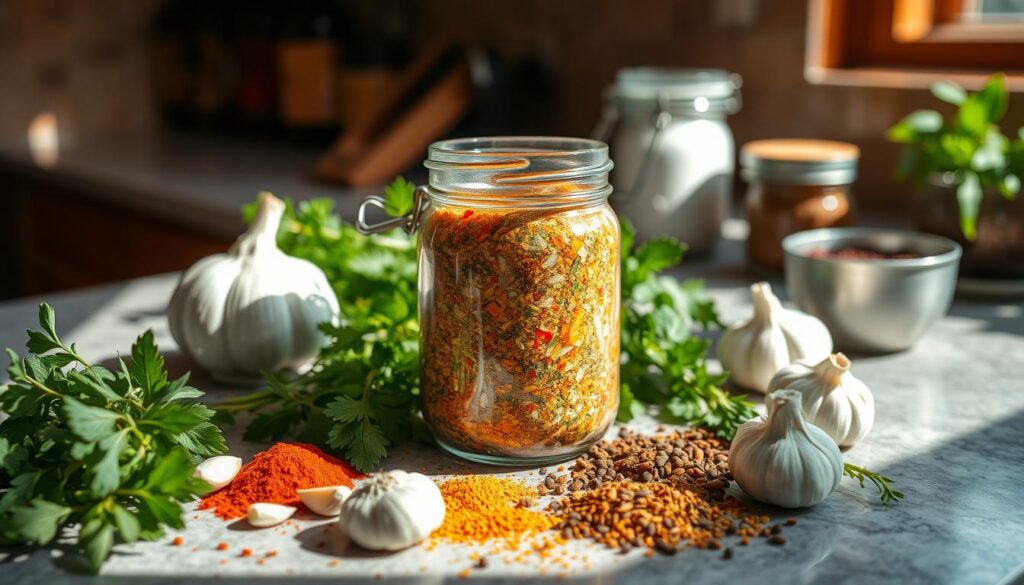Benefits of Brined Chicken: Best Recipes
Benefits of Brined Chicken
As I stood at the kitchen counter, the smell of perfectly seasoned chicken filled the air. It reminded me of the magic of brining. This simple trick can make your home-cooked meals taste like they came from a restaurant, with hardly any work.
Table of Contents
Brining means soaking chicken in a saltwater mix. It’s a big deal for making chicken moist and full of flavor. This guide will show you how brined chicken can make your meals better, from being tender and juicy to adding amazing tastes.
Key Takeaways
- Brining chicken breasts for 30 minutes to 1 hour results in noticeably juicier and more tender meat compared to shorter or longer brining times.
- Using cold tap water in the brine is more effective than warm water, leading to better texture and moisture retention.
- The standard brine recipe includes 4 cups of cold water and specific amounts of kosher salt, highlighting the importance of the salt-to-water ratio.
- Brined chicken can be frozen for up to 6 months, maintaining the brine within the meat as frozen water droplets.
- Brined chicken breasts provide approximately 31 grams of protein and only 3.6 grams of fat per serving, making them a lean and nutritious protein choice.
Understanding the Science Behind Brining
Brining has become key in barbecue over the last five years. People often ask about its science and benefits. The author suggests brining for chicken and pork, as it makes them juicier and tastier.
How Salt Transforms Meat
Wet brining is best for adding flavors and covering the meat well. Salt in the brine changes the meat’s proteins. This lets cells hold more moisture.
This makes chicken tender by loosening muscle fibers. It traps liquid inside, keeping it from evaporating while cooking.
Chemical Reactions During Brining
Brining works through osmosis and diffusion, making chicken juicier and tastier. Avoid pre-brined meats from stores to control salt levels. It’s important to watch the salt in brine, rubs, and sauces to avoid too much salt.
Impact on Protein Structure
Brining adds moisture and flavor to meat. It’s especially good for lean meats like chicken breasts and pork chops. A traditional brine uses 1 tablespoon of kosher salt for every cup of water.
Brining times vary based on the meat type. For example, chicken breasts need about 30 minutes, while pork chops need 2 hours.
You can add sugar, alcohol, herbs, and citrus to brines for extra flavor. Brined meats grill or cook well in a skillet or oven. Unused brine can be stored in the fridge forever. But, it’s best not to reuse it after the first use.
Essential Benefits of Brined Chicken
Juicy, tender, and flavorful – these are the hallmarks of perfectly brined chicken. The brining process offers a host of advantages. It makes chicken dishes consistently delicious. By submerging the chicken in a saltwater solution, often enhanced with herbs, spices, and sweeteners, brining helps prevent the meat from drying out during cooking.
One of the primary benefits of brining juicy brined chicken is increased moisture retention. Brined chicken breasts, for example, are able to hold more water. They stay moist and tender even if they are slightly overcooked. This makes brining an invaluable tool for home cooks, who may not have the same level of expertise as professional chefs.
In addition to improved juiciness, brining also enhances the overall flavor profile of the chicken. The salt and any additional seasonings in the brine are able to permeate the meat. They infuse it with rich, robust taste from the inside out. This ensures that every bite of your brine for roast chicken is bursting with delectable flavor.
Another key advantage of brining is its impact on the meat’s texture. By breaking down the connective tissue, brining helps to tenderize the chicken. This creates a more tender and enjoyable eating experience. This makes brined chicken an excellent choice for a variety of cooking methods, from roasting and grilling to frying and baking.
Finally, brined chicken can be stored for longer periods, both in the refrigerator and freezer, without compromising its quality. The chicken brine seasoning helps to preserve the meat’s freshness and prevent spoilage. This allows you to plan ahead and enjoy your juicy, flavorful chicken even longer.
With its numerous benefits, it’s clear that brining is an essential technique for anyone seeking to elevate their chicken dishes. By unlocking the full potential of this versatile protein, brining can transform ordinary chicken into a truly extraordinary culinary experience.
Getting Started with Simple Chicken Brine
Starting with a simple chicken brine is the first step to delicious, juicy chicken. You need just a few things: water, salt, and some optional extras for flavor. By using the right amount of salt and water, you can make ordinary chicken taste amazing.
Basic Brine Ratio Guidelines
The key to a great brine is the water to salt ratio. Start with 1 tablespoon of kosher salt for every 1 cup of cold water. For 4 cups of water, use 4 tablespoons of kosher salt. Remember, different salts have different densities, so adjust as needed.
For 4 cups of water, you might need 4 1/2 tablespoons of Morton’s kosher salt or 3 tablespoons of fine table salt.
Selecting the Right Salt Type
The type of salt you pick is crucial for simple chicken brine. Kosher salt is a top choice because of its clean taste and easy dissolving. Sea salt and Himalayan pink salt also work well, adding a nice flavor to the chicken. But, avoid table salt as it can make the brine too salty and taste metallic.
Temperature Considerations
The water temperature is important for easy meat brining. Use cold tap water for brining chicken breasts. Warm water can make the meat tough. Keep the brine cold in the fridge to prevent bacterial growth and keep the meat tender.
With these tips, you’re ready to make a tasty brine ingredients for your chicken. The secret is finding the perfect mix of water, salt, and seasonings that you like.
Enhancing Moisture and Tenderness
Brining changes the game for juicy, tender chicken. The salt solution lets the meat soak up more water. This keeps the chicken moist and tender, even after cooking.
Brining also breaks down proteins in the chicken. This makes the meat tender and easy to bite into. Brined juicy brined chicken stays moist during cooking. This reduces the chance of dry, tough meat.
The extra moisture from brining spreads flavors evenly in chicken marinade recipes. This results in a more seasoned and tasty dish. Whether you grill, bake, or sauté your poultry brining methods, brined chicken impresses with its juiciness and tenderness.
| Brining Duration | Recommended Time |
|---|---|
| Skinless, Boneless Chicken Breasts | 30 minutes to 2 hours (optimal: 1 hour) |
| Bone-in Chicken Breasts | 3 to 4 hours |
| Whole Chickens | 3 to 4 hours |
Finding the right balance is key to successful brining. Skinless, boneless chicken breasts require 1 to 2 hours. Skin-on, bone-in chicken and whole chickens need 2 to 4 hours for best flavor and tenderness. Proper brining turns even the leanest chicken into moist, tasty dishes.
“Brining chicken breasts helps lock in moisture and flavor throughout the meat, providing a clear advantage over marinating, which only enhances the flavor on the surface.”
Understanding brining’s science and following best practices can take your juicy brined chicken to new heights. This simple technique unlocks the full potential of your poultry.
Flavor Infusion Techniques
A basic salt brine can make chicken moist and tender. But, you can make it even better by adding herbs and spices. These techniques can turn your chicken into a dish that excites your taste buds.
Aromatics and Herbs
Add fresh or dried herbs like rosemary, thyme, and bay leaves to your brine. Crushed garlic and lemon zest can also add a nice aroma. These ingredients will make your chicken taste and smell amazing.
Seasoning Combinations
Try different seasoning mixes to change up your chicken’s flavor. For a savory taste, mix garlic, onion powder, and Italian herbs. For something bolder, use smoked paprika, cumin, and chili powder. Sweet options include brown sugar, molasses, or maple syrup with cinnamon and cloves.
Sweet and Savory Options
Make your brine sweeter with honey, brown sugar, or maple syrup. These sweeteners balance out the saltiness. You can also use apple juice, chicken broth, or pickle juice for a unique flavor.
Play with herbs, spices, and sweeteners to find the perfect brine for you. There are countless ways to make your chicken taste incredible. Try new things and find your favorite flavor combinations.

Time Management and Brining Duration
To get the perfect brined chicken, knowing the right brining time is key. For chicken breasts, aim for 30 minutes to one hour. Brining for 15 minutes adds a light salt flavor but doesn’t change the texture much. But, brining for 2 hours can make the meat too salty.
For bigger chicken pieces or whole birds, brining can take up to 12 hours. But, don’t brine too long, as it can make the meat mushy and too salty. Here’s a simple rule: skinless, boneless chicken breasts should brine for 1 to 2 hours, skin-on, bone-in chicken for 2 to 3 hours, and whole chickens for 3 to 4 hours or overnight.
| Chicken Cut | Recommended Brining Time |
|---|---|
| Chicken Breasts (Skinless, Boneless) | 1 to 2 hours |
| Chicken (Skin-on, Bone-in) | 2 to 3 hours |
| Whole Chicken | 3 to 4 hours or overnight |
The right chicken brine ratios are key for perfect seasoning and moisture. Start with 2 tablespoons of kosher salt per 1 liter of water for a 3% salt concentration. Using more than 1 tablespoon of salt per 1 cup of liquid can make the chicken too salty and spongy.
It’s also important to store the brined chicken properly. Always keep it in the refrigerator until you’re ready to cook. Use stainless steel, enameled, or food-grade plastic containers to avoid any reactions with materials like aluminum or cast iron.
“The key to the juiciest, most flavorful chicken lies in the brine. With the right ratios and timing, you can transform a simple chicken into a culinary masterpiece.”
Professional Tips for Perfect Results
To get the best results when brining chicken, avoid common mistakes. Don’t overbrine or use warm water. This can make the chicken too salty or unappetizing. Stick to the right brine ratio and chill the brine before adding the chicken.
When storing, unused brine for roast chicken can last forever in the fridge if it’s just salt and water. But, if it has herbs, spices, or aromatics, use it within two weeks. After brining, dry the chicken with paper towels. But, don’t rinse it to avoid spreading bacteria.
Common Mistakes to Avoid
- Overbrining: Too much salt or brining too long can make chicken too salty.
- Using warm water: This can make the chicken absorb too much salt and become waterlogged.
- Rinsing after brining: This can spread bacteria and remove the flavorful brine from the chicken.
Storage Guidelines
- Simple salt-water brines can be stored in the refrigerator indefinitely.
- Brines with added herbs, spices, or aromatics should be used within two weeks.
- Brined chicken can be stored in the refrigerator for up to three days before cooking or frozen for up to two months.
Safety Considerations
For food safety, always brine chicken in the refrigerator if it takes longer than 30 minutes. This prevents harmful bacteria from growing. After brining, dry the chicken with paper towels but don’t rinse it to avoid spreading bacteria.

| Brining Method | Refrigeration Time | Flavor Impact | Skin Texture |
|---|---|---|---|
| Wet Brining | At least 2 hours | Juicier and more flavorful | Crisp and golden brown |
| Dry Brining | As little as 1 hour | Concentrated and seasoned | Extra crispy |
By following these poultry brining methods and guidelines, your brined chicken will always be moist, tender, and flavorful.
Cooking Methods for Brined Chicken
Brined chicken is great for many cooking methods. It’s juicy, tender, and full of flavor. Whether you grill, roast, or pan-sear, the results will be amazing.
Grilling Brined Chicken
Grilling juicy brined chicken is a fantastic choice. The grill’s high heat creates a tasty, caramelized outside. Meanwhile, the inside stays moist and full of flavor. Just remember, brined chicken might cook a bit faster.
Roasting Brined Chicken
Roasting in the oven is another excellent option for brine for roast chicken. The oven’s heat and browning lock in juices and create a golden skin. Keep an eye on cooking times, as brined chicken cooks quicker.
Pan-Searing Brined Chicken Breasts
Pan-searing brined chicken breasts in a cast-iron skillet is a great choice. It results in a crispy exterior and a juicy interior. Watch it closely and use a meat thermometer for the perfect doneness.
Choosing any cooking method, remember to adjust times and temperatures. Brined chicken cooks faster, so use a thermometer for perfect results. This way, you’ll get juicy, flavorful chicken every time.
Conclusion
Brining is a simple yet effective technique that can transform your chicken dishes. It makes them more flavorful and juicy. By understanding the science behind brining and following the guidelines, you can make delicious, restaurant-quality poultry at home.
Whether you choose a basic simple chicken brine or try new flavors, brining is a valuable tool. It helps create tender, flavorful juicy brined chicken.
The benefits of poultry brining methods are clear. They tenderize the meat and add depth of flavor. With practice and experimentation, you’ll find your favorite brining methods and flavors. This will let you unleash your culinary creativity and improve your chicken recipes.
Embrace the power of brining and enjoy the delicious results in your kitchen.
Remember, consistency is key when brining. Make sure to follow the recommended guidelines for meat type, brine ratio, and brining duration. This way, you’ll always get chicken that’s full of flavor and juicy tenderness. Your family and guests will be impressed with your culinary skills.
FAQ
What are the benefits of brining chicken?
Brining chicken makes it juicier, tender, and tastier. It stops the chicken from drying out when cooked. This means it stays moist even if it’s cooked a bit too long.
Brining also lets the seasonings soak into the meat from the inside. This boosts the flavor of the chicken.
How does the science behind brining work?
The salt in brine changes the meat’s proteins. This lets the cells hold more moisture. The meat becomes tender as the proteins unravel and swell, trapping moisture inside.
This process is based on osmosis and diffusion. It makes the chicken juicier, more tender, and flavorful.
What is the basic ratio for a chicken brine?
A basic chicken brine uses water and salt. The standard mix is 1 tablespoon of kosher salt per cup of water. It’s important to use kosher salt because it has the right density.
How long should you brine chicken?
Brine chicken breasts for 30 minutes to one hour for the best results. Brining for 15 minutes adds a light salt flavor without changing the texture.
Brining for 2 hours can make the meat too salty. Brining for 4 hours or more can make it too salty and change its texture.
What are some common errors to avoid when brining chicken?
Don’t over-brine or use warm water. Always store unused brine in the fridge. If brining for more than 30 minutes, do it in the fridge.
After brining, use paper towels to pat the chicken dry. Don’t rinse it, as this can spread bacteria.
How can you enhance the flavor of brined chicken?
While a basic salt brine works well, adding aromatics and herbs can improve the flavor. Try garlic, rosemary, thyme, sage, peppercorns, and bay leaves.
For a sweet and savory taste, add sugar, brown sugar, or molasses to the brine.
What are the best ways to cook brined chicken?
Brined chicken is great for many cooking methods. Grilling is especially good because it creates a flavorful crust while keeping the inside juicy.
Oven roasting and pan-searing in a cast-iron skillet are also excellent ways to cook brined chicken.

